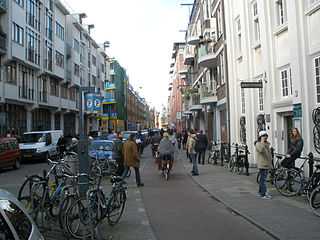Sint Antoniesbreestraat


The Sint Antoniesbreestraat ("St. Anthony's Broad Street") is a street in the centre of Amsterdam in the Netherlands. The street runs south from Nieuwmarkt square to the Sint Antoniesluis sluice gates.
Today, Sint Antoniesbreestraat is primarily a shopping street with a variety of specialty shops. At the corner of Sint Antoniesbreestraat and Hoogstraat is an entry to the Nieuwmarkt stop of the Amsterdam Metro system.
The street was originally a dike, the Sint Antoniesdijk, built to protect the city from flooding. Since the second half of the 17th century, the southern section of the street (south of the sluice gates) has been called Jodenbreestraat ("Jewish Broad Street").
In the 17th century, the street was popular with artists such as the painter Rembrandt, who lived there from 1631 to 1635, at the home of art dealer Hendrick van Uylenburgh, and again from 1639 to 1656, in his own home (now in the Jodenbreestraat), which was built in 1606 and now serves as the Rembrandt House Museum. Other painters who lived in the street include Esaias Boursse, who lived next door to Rembrandt, Nicolaes Eliaszoon Pickenoy, Cornelis van der Voort, Roelant Savery, Pieter Lastman (in whose workshop Rembrandt served as apprentice), Justus and Johannes Vingboons, their father David Vinckboons and the burgomaster Geurt van Beuningen.[1] Joan Huydecoper and Isaac de Pinto grew up here.
Pinto's 17th-century house with an Italianate facade, the Huis De Pinto (or Pintohuis), still stands. The property was purchased by Pinto in 1651 and was remodeled immediately. Upon its renovation, the building was the "talk of the town" due to the dramatic style of exterior and interior.[2] The building now serves as a public library. Across from the De Pinto House is a gate giving access to the Zuiderkerkhof, the square where the Zuiderkerk church stands.
The streets runs through the former Jewish quarter of Amsterdam.[2] During World War II, many residents were taken away to the Nazi concentration camps and the neighbourhood was left practically deserted. After the war, the abandoned houses were left in a decrepit state and many were torn down. Plans were made to build new houses, as well as a highway and metro line through the street. These plans were met by heavy rioting in 1975. The highway plans were eventually abandoned; the metro however was constructed. New houses were built along the existing Sint Antoniesbreestraat, and the Huis de Pinto, which had become a symbol of the movement to save the neighbourhood, was renovated and now serves as public library.
Coordinates: 52°22′14″N 4°54′02″E / 52.37056°N 4.90056°E
References
| Wikimedia Commons has media related to Sint Antoniesbreestraat. |
- ↑ Flip ten Cate: Dit volckje seer verwoet: een geschiedenis van de Sint Antoniesbreestraat. Amsterdam: Pantheon, 1988. ISBN 90-72653-01-7
- ↑ 2.0 2.1 Martin Dunford (2010). The Rough Guide to The Netherlands. Penguin. p. 70. ISBN 978-1-84836-882-8.